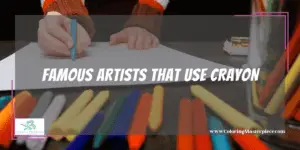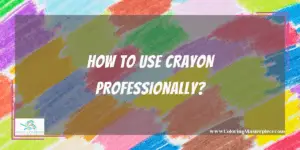Do you remember coloring at the table when you were younger? Your little legs dangled off the chair, not quite long enough to reach the floor, and you used your crayons furiously and intentionally. In your mind, you were no less than a professional artist, despite what people might later tell you.
Yes, professional artists use crayons. Not only do they use crayons, but they also use them well, and it seems like people are always surprised by what can be done with a stick of colored wax.
If you were ever told that to be a professional artist you would have to ditch the Crayolas I’m here to tell you there’s no reason to do that. Plenty of artists have had success and recognition with this medium despite the stigma around it and the difficulties that come along.
Famous Artists That Use Crayon

Perhaps the most famous professional crayon artist is Don Marco. He didn’t start as an artist, but he ended up one. Marco used crayons and drew while working in air traffic control in Hawaii, but he didn’t pursue art professionally until after he retired in 1973. After publishing his first work that year, he went on to draw anything from animals to landscapes, but most people. Most of Don Marco’s work you’ll see will be portraits. What makes his work even more remarkable is the fact that he used solely Crayola crayons. He said that he could get five or six drawings from one crayon, and estimated that he still only used one-third of the crayon for drawing. Another third was lost to constant shaving to keep the crayon sharp, and the last third was thrown away when it became too small to deal with.
Marco’s phenomenal portraits are the work of his mastery of skin tone. Anyone who has used Crayola knows that their “flesh” color was not one size fits all, and it barely fit any. Don Marco would use a light peach color to mark out features before masterfully blending colors to create realistic portraits. Other notable crayon artists have one thing in common: studying under Don Marco.
Filipino artist Marc John Israel started out honing his craft on Deviantart and in Facebook groups, but he notes touching base with Don Marco for tips and techniques. You can find him here and here. Another popular artist who studied under Don Marco is Kristina Nelson. She’s used Crayola and Roseart crayons, but, like Marco she prefers Crayola. Most of her work is done on acid-free paper. When you look at her hyper-realistic nature drawings it’s hard to believe they’re done with only crayons.
Brands of Crayon Used for Professional Art
Contrary to most art mediums, it seems that the most preferred crayon brand for professional artists is Crayola. This is likely due to availability and comfort with the brand. Crayola crayons have an incredible variety of colors to choose from, so it’s easy to find what you’re looking for (especially since crayons don’t blend well). They’re great for starting, making sure crayons are something you want to work with before spending more money.
Some more professional brands include:
- Caran d’Ache Neocolor I: These are similar to the typical set of crayons. They apply smooth and creamy and function more like a crayon than an oil pastel.
- Caran d’Ache Neocolor II: A step away from their sister product, Neocolor IIs are water-soluble. This means you can treat them like a watercolor, drawing or coloring and then painting over them with water.
- Conté Crayons: If you love history you’ll love these. They’ve been around since their invention in 1975 by Nicolas-Jacques Conté. Since then they’ve been used by famous names (Degas? Picasso? Ring a Bell?) They are square-shaped, so you have to adjust your grip on them.
- Lyra Graphite Crayons: These are amazing because they’re grayscale. They’re fantastic for sketching, but the biggest would likely be their water solubility. You can order regular or water-soluble graphite, and they come in 2B, 6B, and 9 B.
Pros of Using Crayon
Crayon can be a cheaper medium to use, even if you’re using a pricier set. The feeling of using crayons can be nostalgic for some artists, and it may spark your inner child. Using the heated paper method they can cover the surface with bold color quickly and smoothly. Theoretically, you can use every piece of the crayon (except maybe the paper) in your work, so nothing goes to waste. This also gives you plenty of different application styles.
Crayons are convenient to use. Unlike paint, you don’t have to set up or take down your workspace.
Cons of Using Crayon
I mentioned before that you might be nostalgic when using crayons. While I think this is a good thing, it can also be perceived as bad. You may have to remind yourself that you’re professionally using crayons and prevent yourself from dropping back into adolescent habits. If you’re prone to mistakes with your art you should know that crayons are nearly impossible to erase. You’re probably used to working around this, but it’s important enough to point out. Crayons resist easily, so they’re hard to blend. You’ll likely need to develop some blending skills specifically for crayons. (I’ll go over a few later in this article, so don’t worry.) This also means it will be difficult to draw anything on top of a layer of crayon. If you need to you can always use acrylic paint, gesso, or India ink on top.
How to Use Crayon Professionally?

As with any medium, you will want to experiment with them in your way. Make sure you get a feel for how they perform, what pressure you need to use, how to layer them, and how holding them in different ways changes their application.
That being said, there are a few general tips that can get you started.
- Start with Crayola. Start with something cheap, but quality. Crayola may be school crayons, but they’re still a step up from what might be sold at your local dollar store. (Besides, there are plenty of artists that have done well off these alone.)
- Use paper that will grip evenly. Because Crayons are a stick of colored wax-textured paper can be difficult to fill in.
- Apply deliberately. Keep your point sharp, and make sure you don’t mark anywhere the color won’t be going. It’s extremely difficult, if not impossible, to erase crayons.
- Build colors. Start with your lightest colors, and layer them. Crayons don’t blend as easily as colored pencils, so you’ll want to look for better transition values.
- Use as few layers as possible. Wax is notorious for resisting, so don’t expect crayons to put up with a plethora of layers.
- Use a craft knife to etch out details. Wax is also easy to scratch, and there’s no reason you shouldn’t use that to your advantage.
- Use a pencil sharpener. Don’t bother with the crayon box sharpener.
- Keep your shavings. They’re great for adding texture or melting.
Blending Crayons
This gets its tip section because while crayons are pretty difficult to blend there are a few methods to make your life easier. (Alisa Burke is an angel for sharing these.)
- Baby Oil 1: Dip a cotton swab in baby oil. Starting with a dark color, blend out. Keep in mind that thinner paper will soak up the oil quickly, so this method works better with thick paper.
- Baby Oil 2: Scribble on another sheet of paper. Use an oil-soaked cotton swab, and pick up the color of the scrap sheet of paper. Now you can use the swab to place the color where you want it. If you shade over it with a crayon the oil helps place the color more smoothly. (Because these methods use oil there is a chance of your drawing getting a bit oily. It shouldn’t be a problem unless you use too much oil, but you can dab the oil off the paper or use a thicker paper.)
- Heat the Paper: It sounds weird at first, but it makes sense when you think about it. If the paper is warm when you apply color the crayon will go on in a smooth way that makes it easy to cover the surface area and blend.
Wondering how to blend colored pencils? Check out our article HERE!
Frequently Asked Questions
How do you seal crayon drawings?
You’ll want to use a fixative spray to protect any art you make with crayons. Pay close attention to instructions, but generally, with crayons, you’ll want to use several light layers instead of one heavy one.
What is an encaustic painting?
Encaustic painting is painting with hot wax (melted crayons work). It creates a beautifully textured and rich look.
Are all crayons water soluble?
Not all crayons are water-soluble, so if you’re looking for water solubility make sure it’s mentioned in the product description. Alternatively, you can use watercolor over crayons for an interesting mixed-media look.
Maximize the benefits of coloring with my free adult coloring eBook and by signing up for my email newsletter HERE!
Disclaimer: The information provided by ColoringMasterpiece.com (“The Site”) is for general informational purposes only. All information on the Site is provided in good faith, however, we make no representation or warranty of any kind, express or implied, regarding the accuracy, adequacy, validity, reliability, availability, or completeness of any information on the Site. Under no circumstance shall we have any liability to you for any loss or damage of any kind incurred as a result of the use of the Site or Reliance on any information provided on the Site. Your use of the Site and your reliance on any information on the Site is solely at your own risk. This blog post is for educational purposes only and does not constitute legal advice. Please consult a legal expert to address your specific needs.
Terms and Conditions: https://coloringmasterpiece.com/terms-and-conditions/
